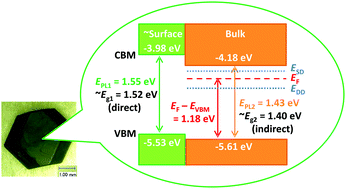当前位置:
X-MOL 学术
›
Phys. Chem. Chem. Phys.
›
论文详情
Our official English website, www.x-mol.net, welcomes your
feedback! (Note: you will need to create a separate account there.)
Energy level diagram of HC(NH2)2PbI3 single crystal evaluated by electrical and optical analyses
Physical Chemistry Chemical Physics ( IF 2.9 ) Pub Date : 2017-12-22 00:00:00 , DOI: 10.1039/c7cp07477h Takeyuki Sekimoto 1, 2, 3, 4 , Michio Suzuka 1, 2, 3, 4 , Tomoyasu Yokoyama 1, 2, 3, 4 , Ryusuke Uchida 1, 2, 3, 4 , Shin’ichi Machida 1, 2, 3, 4 , Takashi Sekiguchi 1, 2, 3, 4 , Kenji Kawano 1, 2, 3, 4
Physical Chemistry Chemical Physics ( IF 2.9 ) Pub Date : 2017-12-22 00:00:00 , DOI: 10.1039/c7cp07477h Takeyuki Sekimoto 1, 2, 3, 4 , Michio Suzuka 1, 2, 3, 4 , Tomoyasu Yokoyama 1, 2, 3, 4 , Ryusuke Uchida 1, 2, 3, 4 , Shin’ichi Machida 1, 2, 3, 4 , Takashi Sekiguchi 1, 2, 3, 4 , Kenji Kawano 1, 2, 3, 4
Affiliation

|
Recently, organic–inorganic halide perovskites have received attention for applications in solar cells. Measurements of high-quality single crystals reveal lower defect densities and longer carrier lifetimes than those of conventional thin films, which result in improved electrical and optical properties. However, single crystal surfaces are sensitive to exposure to ambient conditions, and degrade under long-term storage in air. The surface also shows differences from the bulk in terms of its optical and electronic characteristics. For a heterojunction device, the interface at the single crystal is important. Understanding the difference between the surface and bulk properties offers insights into device design. Here, we prepared non-sliced and sliced formamidinium lead iodide (FAPbI3; FA+ = HC(NH2)2+) single crystals with a bandgap of 1.4 eV, which matches well with the requirements for solar cell photoabsorption layers. We evaluate the energy level diagrams of the surface and bulk regions, respectively. Our data indicate that the valence band maximum of the surface region is at a higher energy level than that of the bulk region. We also discuss hypotheses for the well-known and unexplained phenomena (multiple bandgaps and bandgap narrowing) seen in the absorption and photoluminescence spectra of single crystals. We conclude that these effects are likely caused by a combination of the degraded surface, Rashba-splitting in bulk, and self-absorption by the single crystal itself.
中文翻译:

通过电学和光学分析评估 HC(NH 2)2 PbI 3单晶的 能级图
最近,有机-无机卤化物钙钛矿已在太阳能电池中得到关注。与常规薄膜相比,高质量单晶的测量显示出更低的缺陷密度和更长的载流子寿命,从而改善了电学和光学性能。然而,单晶表面对暴露于环境条件敏感,并且在空气中长期储存下会降解。该表面在光学和电子特性方面也显示出与整体的差异。对于异质结器件,单晶的界面很重要。了解表面特性和体积特性之间的差异可提供对器件设计的见解。在这里,我们准备了未切片和切片的甲ami碘化铅(FAPbI 3 ; FA += HC(NH 2)2 +)单晶体,带隙为1.4 eV,与太阳能电池光吸收层的要求非常匹配。我们分别评估了表面区域和主体区域的能级图。我们的数据表明,表面区域的价带最大值处于比主体区域的价带更高的能级。我们还将讨论在单晶的吸收和光致发光光谱中发现的众所周知且无法解释的现象(多个带隙和带隙变窄)的假设。我们得出的结论是,这些影响可能是由降解的表面,大量的拉什巴分裂以及单晶自身的自吸收所引起的。
更新日期:2017-12-22
中文翻译:

通过电学和光学分析评估 HC(NH 2)2 PbI 3单晶的 能级图
最近,有机-无机卤化物钙钛矿已在太阳能电池中得到关注。与常规薄膜相比,高质量单晶的测量显示出更低的缺陷密度和更长的载流子寿命,从而改善了电学和光学性能。然而,单晶表面对暴露于环境条件敏感,并且在空气中长期储存下会降解。该表面在光学和电子特性方面也显示出与整体的差异。对于异质结器件,单晶的界面很重要。了解表面特性和体积特性之间的差异可提供对器件设计的见解。在这里,我们准备了未切片和切片的甲ami碘化铅(FAPbI 3 ; FA += HC(NH 2)2 +)单晶体,带隙为1.4 eV,与太阳能电池光吸收层的要求非常匹配。我们分别评估了表面区域和主体区域的能级图。我们的数据表明,表面区域的价带最大值处于比主体区域的价带更高的能级。我们还将讨论在单晶的吸收和光致发光光谱中发现的众所周知且无法解释的现象(多个带隙和带隙变窄)的假设。我们得出的结论是,这些影响可能是由降解的表面,大量的拉什巴分裂以及单晶自身的自吸收所引起的。










































 京公网安备 11010802027423号
京公网安备 11010802027423号